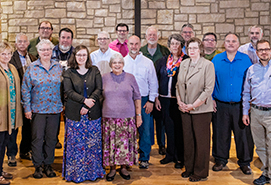This issue of Brethren Life & Thought presents four feature articles and five book reviews. Two articles are on atonement, which has traditionally been a doctrinal balance sheet of sorts for Christians. The first article, authored by Thomas Finger, defines atonement as “at-one-ment” or reconciliation with God which can be accomplished not only by turning away from sin but by living according to the teachings of Christ. The second article, authored by Kate Eisenbise, critiques the eschatalogical implications of J. Denny Weaver’s “narrative Christus Victor” model of atonement. The third feature article, authored by Val Freidell, offers a new look at the beloved tradition of Love Feast. In the fourth article Jeff Neuman-Lee contributes “The Map,” a chapter from a primer on theology he has written for Christians called God With Us. This article helps Bible readers navigate scripture using a variety of vantage points.
With this issue we are introducing a new study resource. Below you will find initial study questions, with links to more questions. We hope these questions will stir your mind to deeper understanding of faith and practice. Use them for yourself, and/or as resources to lead a group discussion!
Atonement, Ethics, Society, and Violence
by Thomas Finger (BLT pages 1-8)
Finger argues that a central purpose of our faith is to search for “at-one-ness” with God. How have you, in your life, become at one with God? Can you point to a moment or to someone who helped you see the way?
Finger asks his own question. If the death of Jesus is the key action in the New Testament, why do the Gospels give so much attention to the teachings of Jesus?
For further study: more questions for reflection (pdf)*
Resurrection as Victory?
by Kate Eisenbise (BLT pages 9-22)
J. Denny Weaver writes “Neither the purpose nor the culmination of the [Christ’s] mission was to die. God did not send Jesus to die, but to live, to make visible and present the reign of God.” If Jesus’ death was not necessary, is it meaningful nonetheless? What does it mean to you?
“Suffering is not itself salvific; it is a by-product of opposing evil, the price for beginning to resist.” In this respect, people suffer for faithfulness and people suffer for sin. Which actions produce the “right” suffering? For example, is the suffering associated with parenthood the kind of suffering produced by faithfulness? Why or why not?
For further study: more questions for reflection (pdf)*
A Community of Friends: John 13: 1-17
by Val Friedell (BLT pages 23-32)
In what ways does the Love Feast depict service? Cleansing? Jesus’ approaching death and resurrection? The beginning of the church? Love for friends? Other? Which is most meaningful to you? Why?
Raymond E. Brown believes Jesus provides an example in John 13 of laying down one’s life in order to create life. How does the sacrifice of Jesus’ life create new life?
for further study: more questions for reflection (pdf)*
The Map
by Jeff Neuman-Lee (BLT pages 33-45)
One problem with analogies or comparisons is that we sometimes confuse the symbol for the real thing. What danger, if any, is there in comparing God to a shepherd, a rock, a fortress, a garden, or any other common object?
Jesus scoffs at the need for signs of his true identity. Proof of the truth seems worthless to him. Why? How might Jesus describe the difference between faith and knowledge?
For further study: more questions for reflection (pdf)*








 Green Circle: Bethany invests in 100% renewable energy.
Green Circle: Bethany invests in 100% renewable energy.